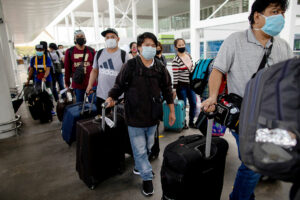




Quarterly Economic Growth Release: More BSP cuts to come
 DOWNLOAD
DOWNLOAD

Monthly Economic Update: Fed catches up
 DOWNLOAD
DOWNLOAD

Inflation Update: Steady and mellow
 DOWNLOAD
DOWNLOAD


Cash remittances hit 6-month low

MONEY SENT HOME by overseas Filipino workers (OFWs) in November grew by 5.7% to USD 2.644 billion, the lowest amount in six months, data from the Bangko Sentral ng Pilipinas (BSP) showed.
This was the quickest annual growth in 17 months or since the 7% in June 2021, and above the BSP’s 4% full-year target.
However, the amount of money sent by OFWs to the Philippines in November was the lowest in six months or since the USD 2.43 billion in May 2022. It also declined by 9.2% from the $2.911 billion in October.
 For the January-to-November period, cash remittances coursed through banks rose 3.3% to $29.38 billion, from USD 28.43 billion a year earlier. This was below the BSP’s 4% remittance growth target for 2022.
For the January-to-November period, cash remittances coursed through banks rose 3.3% to $29.38 billion, from USD 28.43 billion a year earlier. This was below the BSP’s 4% remittance growth target for 2022.
In a statement, the BSP attributed the growth in cash remittances in November to higher receipts from land- and sea-based workers.
Cash remittances from land-based OFWs jumped by an annual 5.6% to USD 2.08 billion in November, while inflows from sea-based workers increased by 5.9% to USD 564.972 million.
OFWs may have sent more money to their families as inflation continued to accelerate, analysts said.
Headline inflation quickened to a 14-year high of 8% in November from 7.7% in October and 3.7% in November 2021, breaching the BSP’s 2-4% target range for an eighth straight month.
“As expected, November OFW remittances growth has risen further from a year ago as OFWs sent more money for the holiday celebrations,” UnionBank of the Philippines, Inc. Chief Economist Ruben Carlo O. Asuncion said in a Viber message.
Rizal Commercial Banking Corp. Chief Economist Michael L. Ricafort said cash remittances may have slumped to a six-month low due to the peso’s depreciation against the US dollar.
“The slowdown in OFW remittances amount to 6-month lows may have to do with the relatively higher US dollar/peso exchange rate compared to early 2022… that partly led to a lower amount of US dollars sent by OFWs to the country, given the higher equivalent of these remittances when converted to pesos,” he said in an e-mail note.
The peso rebounded to the P56-a-dollar mark in November, closing the month at PHP 56.56, up by PHP 1.41 or 2.5% from its PHP 57.97 finish on Oct. 28.
“(Overseas Filipinos) tend to compensate for challenges onshore. With inflation hitting multi-year highs, we could see remittances show decent growth despite concerns about a global slowdown,” ING Bank N.V. Manila Senior Economist Nicholas Antonio T. Mapa said in a Viber message.
In the 11 months to November, the BSP said there were higher inflows from the United States, Saudi Arabia, and Singapore.
The United States was the biggest remittance source with a 41.4% share. It was followed by Singapore (6.9%), Saudi Arabia (5.8%), Japan (5.1%), the United Kingdom (4.7%), the United Arab Emirates (4.2%), Canada (3.6%), Qatar (2.8%), Taiwan (2.7%), and South Korea (2.5%).
Remittances from the top 10 countries cumulatively made up 79.7% of the total during the 11-month period.
Meanwhile, personal remittances, which include inflows in kind, grew by 5.8% to $2.93 billion in November from USD 2.77 billion a year ago.
This brought the year-to-date level to USD 32.65 billion, up by 3.4% against the USD 31.59 billion logged in the January-to-November 2021 period.
China Banking Corp. Chief Economist Domini S. Velasquez said remittance growth likely remained positive in December as OFWs sent more money for holiday celebrations and for the resumption of face-to-face classes.
“Improving sentiments in sending countries, such as the US and Asia, will help support growth,” she said in a Viber message.
All public and private schools should have transitioned to five days of face-to-face classes starting November, the Department of Education earlier said.
Ms. Velasquez said remittances usually increase when economic conditions in a country decline.
“For example, overseas Filipinos likely sent more money to help alleviate inflationary pressures. In December also, we saw an increase in overseas Filipino arrivals which can prompt higher spending in anticipation of the holidays,” she added.
“With inflation topping out at 8.1% we could see Filipinos based abroad send more cash to help beneficiaries cover expenses for the holidays,” Mr. Mapa likewise said.
The BSP expects cash remittances to grow by 4% again this year. – Keisha B. Ta-asan, Reporter
This article originally appeared on bworldonline.com





 By BusinessWorld
By BusinessWorld